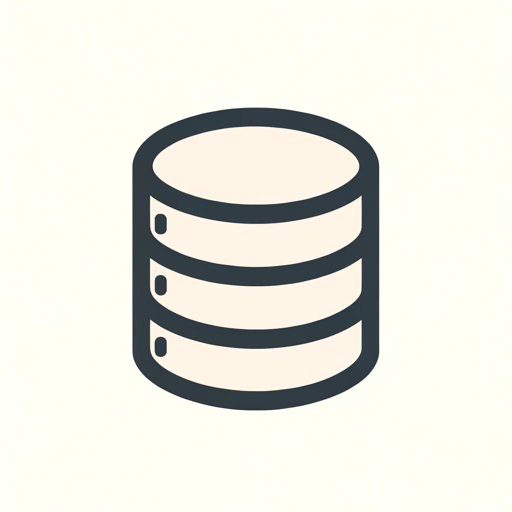PostgreSQL (Postgres)-AI-powered database management
Harness AI for powerful PostgreSQL management
💡 Best practices for indexing in PostgreSQL?
✏️ Optimize and fix errors in this PostgreSQL query
🧠 Explain to me normalization in PostgreSQL
⚙️ Create an example PostgreSQL query
Related Tools
Load MorePostgres Expert
The GPT does act as an PostgreSQL Dataase Exrpert, It masters the knowledge of Postgres very well.

Supabase Expert
Expert in Supabase, PostgreSQL, and TypeScript for app development.

PostgreSQL Assistant
Expert in PostgreSQL data modeling and querying.

PostgreSQL Support Engineer
PostgreSQL expert focusing on technical support and troubleshooting, with restricted access

POSTGRES GPT
Expert in SQL queries and PostgreSQL, adept at navigating complex database structures and optimizing data management.

PSQL Pro
Formal, precise expert in PostgreSQL and database theory.
20.0 / 5 (200 votes)
Introduction to PostgreSQL
PostgreSQL, often referred to as Postgres, is an open-source relational database management system (RDBMS) known for its robustness, scalability, and compliance with SQL standards. It is designed to handle a range of workloads, from single-machine applications to large internet-facing applications with many concurrent users. PostgreSQL's core design goals include extensibility and standards compliance, which means it can be customized with various extensions and supports a wide array of SQL features and data types. Example: A financial institution may use PostgreSQL to manage its transaction records due to its strong ACID (Atomicity, Consistency, Isolation, Durability) compliance, ensuring data integrity even in the event of system failures.

Main Functions of PostgreSQL
Data Integrity and ACID Compliance
Example
Ensuring transactional integrity in financial systems.
Scenario
A bank uses PostgreSQL to manage transactions, ensuring that all operations are completed successfully and maintaining data consistency even if a transaction fails midway.
Advanced Data Types
Example
Handling complex data in geographic information systems (GIS).
Scenario
A GIS application uses PostgreSQL with PostGIS extension to store and query spatial data, allowing for efficient geographic calculations and map visualizations.
Extensibility
Example
Customizing the database to support specialized functions.
Scenario
A bioinformatics company extends PostgreSQL with custom modules to support specific data analysis tasks, such as handling genomic data formats and performing specialized queries on them.
Ideal Users of PostgreSQL
Large Enterprises
Large enterprises benefit from PostgreSQL due to its scalability, reliability, and support for complex queries and large datasets. Companies like Apple, Fujitsu, and Cisco use PostgreSQL for its robustness and ability to handle high-volume transactions.
Startups and Small Businesses
Startups and small businesses benefit from PostgreSQL's open-source nature, which reduces costs while providing a powerful database solution. Its flexibility and support for modern development frameworks make it an ideal choice for agile development environments.

Steps to Use PostgreSQL (Postgres)
1
Visit aichatonline.org for a free trial without login, also no need for ChatGPT Plus.
2
Install PostgreSQL on your machine by downloading it from the official PostgreSQL website and following the installation instructions.
3
Configure your PostgreSQL instance by setting up user roles, databases, and necessary permissions using SQL commands or a graphical interface like pgAdmin.
4
Create and manage databases using SQL queries. You can create tables, insert data, and run queries to interact with your data.
5
Optimize and maintain your database by performing regular backups, updates, and monitoring performance using PostgreSQL tools and extensions.
Try other advanced and practical GPTs
Photo Editor & Beautifier 🌟
AI-powered image beautification.

Code Alfred
AI-Powered Coding Assistant

DALL· Eの 3 Prompt Craft
AI-Powered Tool for Crafting Detailed Prompts

Kubernetes
AI-powered Kubernetes management tool.

Chinese History 中国历史
AI-powered insights into Chinese history

论文降重
AI-Powered Solution for Unique Academic Texts

Alaina
AI-powered insights for property management.

Scott's PCI DSS Guru
AI-powered PCI DSS Compliance Tool

Qt5 C++ Guide
AI-powered Qt5 & C++ Insights.

全书速读
AI-Powered Book Summarization Tool.

AI報道官 福澤幸吉
Create sensational headlines and summaries with AI.

Canadian Tax GPT
AI-powered Canadian Tax Insights.

- Web Development
- Business Intelligence
- Data Analytics
- Cloud Services
- Geospatial Data
Detailed Q&A About PostgreSQL (Postgres)
What is PostgreSQL?
PostgreSQL is a powerful, open-source relational database management system that supports a wide range of data types and advanced SQL functionalities.
How do I connect to a PostgreSQL database?
You can connect to a PostgreSQL database using command-line tools like psql, or through graphical tools like pgAdmin. Additionally, you can use various programming languages such as Python, Java, and PHP with appropriate database drivers.
What are the key features of PostgreSQL?
PostgreSQL offers features such as ACID compliance, support for advanced data types (JSON, XML), full-text search, and extensions like PostGIS for geospatial data.
How can I back up and restore a PostgreSQL database?
You can back up a PostgreSQL database using the pg_dump utility and restore it using the pg_restore utility. These tools provide options for both full and partial backups, as well as flexible restoration options.
What are some common use cases for PostgreSQL?
Common use cases include web applications, data warehousing, geospatial databases, and complex analytical queries. PostgreSQL's robustness and flexibility make it suitable for various types of data-driven applications.